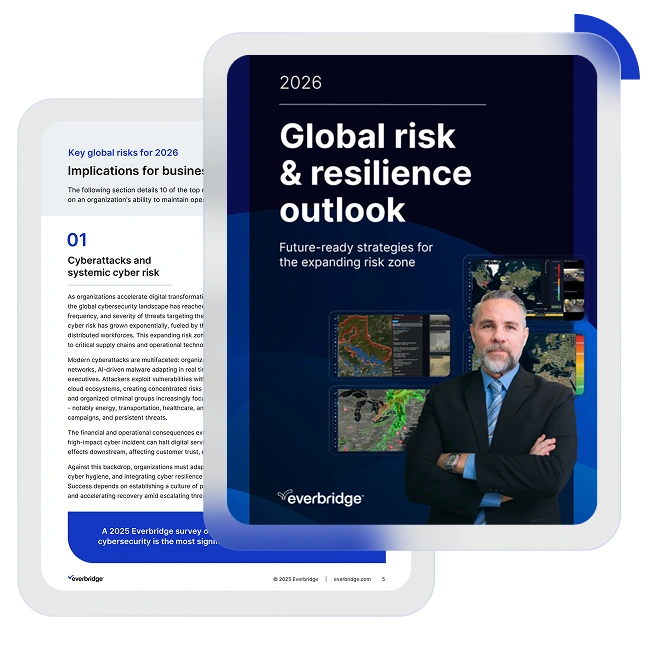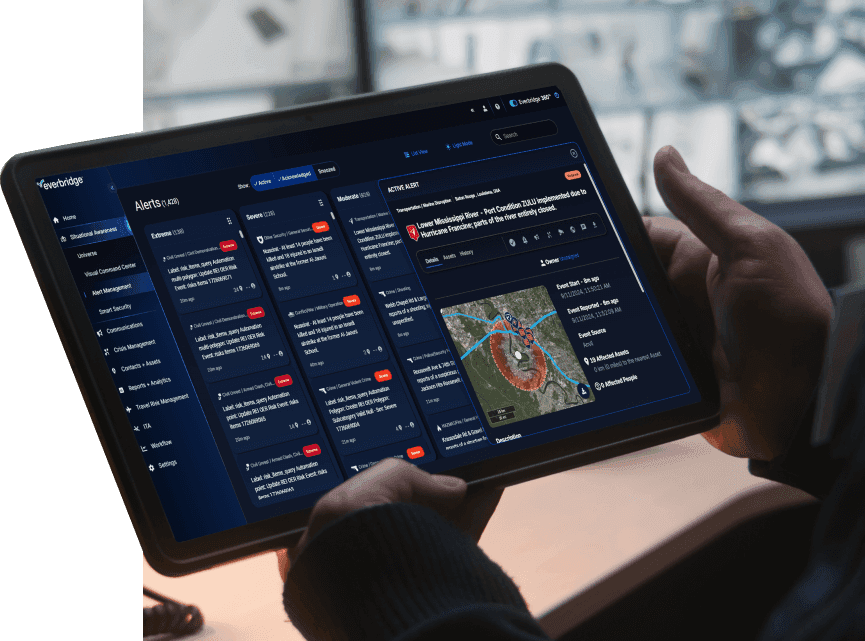A guide to future-ready resilience
The risk landscape is becoming increasingly complex and interconnected. Threats now span industries and regions, requiring businesses to move beyond traditional continuity planning. This blog explores the concept of an “expanding risk zone” and examines the top global risks facing organizations in the year ahead.
The expanding risk zone
Organizations today operate within an “expanding risk zone,” a term that describes the increased exposure to more frequent and intense critical events. This environment challenges outdated business continuity models. Threats no longer happen in isolation; they are often simultaneous and interconnected, creating systemic risk clusters that impact social, operational, and financial domains.
This interconnectedness creates new vulnerabilities. A single event can trigger a cascade of disruptions across your operations and supply chain. As a result, resilience is no longer just a compliance task. It is a strategic imperative for sustained operations and a real competitive advantage. According to a survey conducted here at Everbridge in October 2025, only 31% of global leaders feel extremely confident in their organization’s ability to manage critical events, highlighting a significant readiness gap.
Top 10 global risks for 2026
The Everbridge “2026 Global Risk & Resilience Outlook” identifies 10 critical global risks that organizations must prepare for. Understanding these risks is the first step toward building a future-ready enterprise.
1. Cyberattacks and systemic cyber risk
As businesses adopt more connected technologies, the cybersecurity landscape has become a major concern. Attackers now use sophisticated methods like AI-driven malware and deepfake-enabled social engineering. They target not just core systems but also critical supply chains and operational technology (OT), creating risks that can paralyze entire industries. The impact goes beyond data loss, leading to months of downtime and severe reputational damage.
2. The dual edge of AI
Artificial intelligence offers powerful tools for anticipating and managing critical events. It can enhance decision-making and automate responses. However, AI also amplifies risk. Malicious actors use it to scale attacks and create convincing phishing schemes. The rapid adoption of generative AI, often without strong governance, exposes companies to data leaks, compliance breaches, and biased outcomes.
3. Natural disasters and climate-driven extremes
Extreme weather events like hurricanes, wildfires, and floods are becoming more frequent and intense. These disasters cause direct disruptions to facilities and also have cascading effects on supply networks and regional economies. With rebuilding timelines getting longer and insurance coverage becoming more selective, the chronic risk of interruption is a major challenge to operational resilience.
4. Geopolitical conflict
Geopolitical instability, including tariffs, export restrictions, and sanctions, creates significant volatility. These events disrupt trade flows, create chokepoints in shipping lanes, and cause sudden swings in commodity and energy markets. Organizations that rely on single-region sourcing or just-in-time inventory models are especially vulnerable to these geopolitical shocks.
5. Business interruption from supply chain shocks
Supply chains are more complex and interconnected than ever, meaning a single disruption can quickly halt production and create costly delays. These shocks can come from port congestion, labor shortages, or even digital vulnerabilities. A disruption at a single third-party IT provider, for example, can trigger a “digital domino effect,” spreading operational chaos across multiple enterprises.
6. Misinformation and disinformation
False narratives and deepfake content are rapidly accelerating threats. Targeted campaigns can erode trust, disrupt crisis communications, and manipulate markets. The World Economic Forum has identified misinformation and disinformation as one of the most severe global risks over the next two years. Attacks can damage brands, cause financial loss, and slow an organization’s ability to respond to a crisis.
7. Regulatory fragmentation and trade restrictions
A fragmented patchwork of regulations on issues like data privacy, cybersecurity, and supply chain due diligence creates uncertainty. Sanctions and export controls can change with little notice, forcing companies to adapt continually. This volatility can disrupt cross-border operations, delay shipments, and increase compliance costs, undermining organizational resilience.
8. Macroeconomic and financial instability
Persistent inflation, fluctuating interest rates, and shifting trade policies directly affect working capital, credit access, and revenue streams. These factors can create cash flow pressure, increase costs, and lead to supplier defaults. Even financially sound organizations can face sudden shocks to both supply and demand, testing their financial resilience.
9. Talent shortages and skills mismatch
Demographic shifts and rapid technological change are creating critical skills gaps. When key roles remain unfilled, incident response times lengthen, and institutional knowledge is lost. This erodes business continuity, with longer recovery times and stalled modernization efforts. Treating talent availability as a critical operational risk is now essential.
10. Polycrises
A polycrisis occurs when multiple, independent risks materialize at the same time, amplifying each other’s consequences. For example, a conflict may disrupt supply chains while a cyberattack targets your distributed workforce. This convergence strains operational capacity and overwhelms traditional crisis management protocols, making a coordinated, centralized response critical.
Building a future-ready organization with a five-stage strategy
To navigate the expanding risk zone, leaders need an integrated, proactive approach. Everbridge recommends a five-stage resilience strategy that helps organizations know earlier, respond faster, and improve continuously.
Stage 1: Plan
Move beyond static risk assessments. Use dynamic risk intelligence and scenario planning to anticipate threats and quantify their potential impact. By operationalizing foresight, you can prioritize resources and strengthen business continuity before an event occurs.
Stage 2: Monitor
Maintain 24/7 situational awareness across your people, sites, supply chain, and technology. AI-powered risk intelligence provides the contextual data needed to see disruptions sooner. This allows you to understand who and what is at risk, enabling faster, more informed decisions to protect your operations.
Stage 3: Alert
During a critical event, every minute counts. A high-velocity approach accelerates detection, assessment, and outreach. Use targeted, multi-modal notifications to communicate with clarity and speed. This ensures you can fulfill your duty of care and protect employees, whether they are in the office or traveling.
Stage 4: Respond
Replace fragmented point solutions with a common operating picture. This centralizes decision-making and mobilizes the right people and actions across security, IT, and operations. An orchestrated incident command ensures an efficient and effective response.
Stage 5: Improve
Turn every event into a learning opportunity. Institutionalize continuous improvement with post-incident analysis and performance insights. This full-lifecycle approach helps your teams refine business continuity plans, update playbooks, and strengthen organizational resilience over time.
Securing your organization’s future
The risks facing organizations in 2026 are more complex and interconnected than ever before. The insights from the Everbridge “2026 Global Risk & Resilience Outlook” make it clear that a new approach is needed. Resilience is no longer a static plan, but an ongoing capability that integrates risk management, talent investment, and continuous learning.


